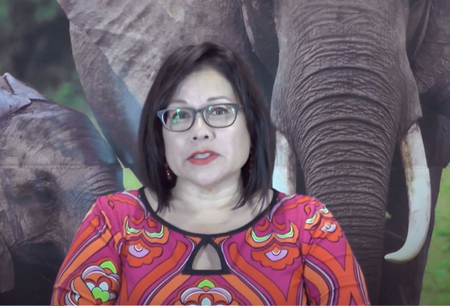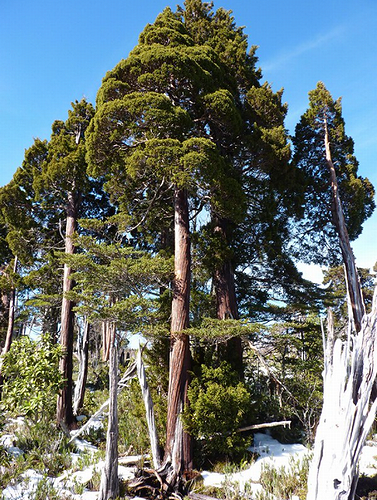The mixed literary, philosophical, and political legacy of the author of The Fountainhead and Atlas Shrugged, forty years after her death.
by CATHY YOUNG
MARCH 6, 2022

View of Russian-born American writer Ayn Rand (1905 - 1982) on the set of the NBC television program 'The Today Show', New York, New York, March 23, 1961. Behind her is a quote from her 1961 book, 'For the New Intellectual'.
Today marks the fortieth anniversary of the death of a writer who has been worshipped, loathed, and ridiculed—and whose legacy, despite all the dismissals by her detractors, still reverberates in the twenty-first century. Ayn Rand, the bestselling novelist, controversial philosopher of “Objectivism,” and secular guru of reason and individualism, died in New York City on March 6, 1982, at the age of 77. As a refugee from Soviet Russia (born Alissa Zinovyevna Rosenbaum) who vehemently rejected not only communism but the religious and nationalist values of pre-revolutionary Russian culture, Rand may be particularly relevant to the current moment, when the new Russia is rebuilding itself as a hybrid of the USSR and the old empire with its pillars of religion and nationalism.
Rand’s works, especially her two best-known novels, The Fountainhead (1943) and Atlas Shrugged (1957), still continue to be read and to draw new and often passionate fans. Yet mainstream culture has mostly regarded her as a quaint niche interest on the right—an intellectual pin-up girl for the likes of Paul Ryan, the former speaker of the House, and Andy Puzder, Donald Trump’s withdrawn nominee for secretary of labor—or treated her as a caricature and a punchline. (Think the “Ayn Rand School for Tots” in a 1992 Simpsons episode, where the Objectivist daycare-center owner bans pacifiers and asserts that a child who reaches for a bottle of milk is being a “leech.”) Conservative culture mavens have not been much kinder: In 2010, New Criterion editor Roger Kimball wrote that he had never been able to make it through much of either Atlas Shrugged or The Fountainhead because each time he tried, he found himself “oscillating between fits of the giggles, at the awful prose, and irritation, at the jejune philosophy.”
Is Rand unfairly maligned, as her admirers assert? In some ways, yes. She did not, as is often implied, worship the rich (most of the wealthy characters in her novels are repulsive or ridiculous, or both), nor did she preach that moneymaking is life’s highest goal. (At one point in The Fountainhead, the hero, visionary architect Howard Roark, describes “the man whose sole aim is to make money” as a variety of “the second-hander” who lives solely through other people, seeking to impress them with his wealth.) The character in the 1987 movie Dirty Dancing who ditches his pregnant girlfriend and brandishes a dogeared paperback of The Fountainhead to explain that “some people count, some people don’t” does not actually exemplify Randian philosophy.
While Rand praised “the virtue of selfishness,” what she meant by the word was something very different from the common meaning. One of the points of The Fountainhead is that mediocre architect Peter Keating, the slick opportunist who uses everything from plagiarism to blackmail to advance his career, would be commonly seen as selfish even though a “self” is precisely what’s absent from his pursuit of success, while Roark would be wrongly seen as self-sacrificing when he would rather be broke than sacrifice his integrity. (Donald Trump, who has fancied himself a Fountainhead fan and Roark wannabe, is in fact a perfect Randian baddie: not only a businessman who thrives on government connections, string-pulling and shady deals, but a man whose sense of achievement is derived mainly from bullying others and being loved.)
Rand’s affirmation of a strong sense of selfhood as the proper foundation of human relationships—“To say ‘I love you’ one must first know how to say the ‘I,’” Roark tells his beloved, Dominique Francon—is a worthwhile message for anyone. Likewise, her formulation of “reason—purpose—self-esteem” as the core principles of the good life in Atlas Shrugged is a powerful distillation of what we often call Enlightenment values. Conversely, her critique of altruism as the foundation of morality led her to some undeniably valid insights: for instance, that altruistic goals can easily become an excuse for bad acts or a vehicle for power-seeking and self-righteous bullying. Rand, who asserted almost a decade before Hannah Arendt that Nazism and communism were not opposites but totalitarian twins—one subordinating the individual to race, the other to class and collective—was almost certainly on to something when she wrote that the habit of equating self-interest with immorality and self-sacrifice with nobility often left democracy’s defenders intellectually disarmed against arguments that communism, at least, teaches people to put others first.
Many of Rand’s admirers have singled out as a particularly important intellectual contribution her defense of the free market as a moral system based on accomplishment and voluntary exchange rather than coercion, as well as her celebration of entrepreneurship as a creative activity rather than mere pursuit of profit. But on this and much else Rand is ill served by her absolutism. She assumes that, absent dirty dealing of one kind or another, individuals rewarded by the market have an absolute moral claim to those rewards as the fruit of their own efforts—which means that not only any redistribution but all involuntary taxation is immoral (Rand believed that necessary government services should ideally be supported via “voluntary financing”). But this view ignores not only the extent to which an individual’s achievement and flourishing is made possible by a vast and intricate civilizational infrastructure, but the role of factors unrelated to personal merit—from family background to sheer luck. Rand was still right when she wrote that “the government is not the owner of the citizens’ income and, therefore, cannot hold a blank check on that income” and that the state should not have “power to enlarge the scope of its services at its own arbitrary discretion.” But her political philosophy and her followers were often unable to reckon with the messy reality and compromises inherent in a government constituted to respect both the individual and the social contract.
Rand’s absolutism also undercuts her arguments on a moral level. Ideas she opposes, such as altruism, are relentlessly strawmanned: If you teach people that it’s praiseworthy to give up something to help others with no thought of your own self-interest, then you’re telling them that they have no right to exist for their own sake and no purpose except to be a “sacrificial animal.” While some accusations of cruelty directed at Rand are based on caricature more than her actual work, it’s difficult to deny that her version of individualism—which bears a Nietzschean stamp Rand denied—has little room for physical afflictions and vulnerabilities. Except for her first major novel, We the Living (more about which in a moment), sick people mostly figure in her work as unworthy recipients of pity, and even private charities are mocked for helping drug addicts and unwed pregnant women.
The way Rand’s philosophy played out in her own life is a stark example of being mugged by reality. Her following, by the admission of former associates who never stopped admiring her work, became so cultlike that people who spoke of freedom and the independent mind felt compelled to admire the same books and music Rand admired. (Objectivist groups even held show trials of members accused of violating Randian precepts.) While her heroes stoically accepted romantic rejection, Rand’s reaction to the revelation that her much younger lover and disciple, Nathaniel Branden, was involved with a still-younger woman was to rail against him, curse him with impotence, and denounce him to her flock for unspecified immoral acts. Her belief that cancer and many other illnesses were the result of “psycho-epistemological errors” led her to conceal her lung cancer diagnosis from her fans (and refuse to retract her previous staunch denial of the hazards of smoking) and to torment her long-suffering husband by trying to reason him out of Alzheimer’s. Her professed commitment to truth did not prevent her from rewriting her history to proudly declare, “No one helped me,” even though she repeatedly received help from relatives, friends, and even charities after coming to the United States.
In other words: Don’t try this philosophy at home, kids.
But Rand is hardly the first philosopher whose ideas cannot survive a close encounter with reality, or the first writer with eccentric philosophical views. And the truth is that, despite her eccentricities, she was a far better writer than Kimball and others recognize—at least until she went full ideologue in Atlas Shrugged and began to use fiction as a vehicle for heavy-handed agitprop. While Atlas has some powerful passages, its hero John Galt is an abstraction with the looks of a Greek god, its villains are a gallery of grotesques, and its plot is weighed down by endless preaching in which the message is hammered into the reader’s head again and again and again. That message subsumes anything that could be recognizable as human emotion: When the wife of industrialist Hank Rearden tries to humiliate him by announcing that she slept with a man he despises, he responds by having philosophical musings (as one does) on “the creed of collective interdependence,” which holds that “the moral stature of one is at the mercy of the action of another.”
But Rand’s earlier works, while always wedded to her ideas, are far more readable and human—and leave little doubt that she was a writer of extraordinary if idiosyncratic talent.
We the Living (1936), set in Petrograd/Leningrad in the early to mid-1920s, paints a compelling picture of life in the Soviet Union as the devastation of revolution and civil war gave way to the “New Economic Policy,” a brief interlude in which private enterprise was grudgingly tolerated along with a fair amount of personal and cultural freedom. At this point, Rand was still flexible enough that she could make some of her commies sympathetic and that her individualistic heroine, Kira Argounova, could have real, tangible bonds with her family despite being its black sheep. Kira’s uncle Vassily, a dispossessed businessman who desperately tries to hold on to his dignity and cling to hope under the new regime, is a particularly tragic figure, while her mother Galina, whose haughty scorn for the new ways gradually shifts to acceptance and then enthusiastic conformism, is depicted with fine and subtle satire. Kira’s tangled relationship with the idealistic Communist Andrei Taganov and the aristocrat Leo Kovalensky, which ends in Andrei’s suicide and Leo’s descent into cynicism and degradation, is a genuinely poignant story with enough unusual twists to make it riveting. And Rand has a knack for the vivid detail, such as the early scene in which a woman traveling on an overcrowded train holes up in the reeking cubicle of the toilet to devour a boiled potato, a rare luxury in a country only starting to climb out of the civil war’s wreckage.
The Fountainhead, almost certainly Rand’s best work, can also be read and appreciated without fully embracing the message. The frequently made claim that Rand’s characters are black-and-white cardboard cutouts does not apply here: Even the despicable Keating is a nuanced character with some sympathetic moments, including the bittersweet story of his thwarted romance with the young woman he truly loves but gives up for a more advantageous marriage. The Citizen Kane-like newspaper tycoon Gail Wynand, Roark’s frenemy and (for a long stretch of the novel) Dominique’s husband, is both odious and noble; many other characters such as Dominique’s father Guy Francon do not neatly fit the good/bad scheme, and even the (very bad) archvillain Ellsworth Toohey has an acid intelligence, wit, and even Mephistophelean charm that place him in an entirely different league from the thoroughly repulsive baddies of Atlas Shrugged.
Likewise, Rand’s prose here has little in common with the later novel’s anvil-heavy propaganda tropes and crass mockery. It can be beautifully evocative (“The air was heavy with untimely darkness, disquieting like premature old age, and there were yellow puddles of light in windows”) and bitingly funny (Wynand’s tabloid, the New York Banner, is described as covering society news in a trashy way that “gave the man on the street two satisfactions: that of entering illustrious drawing rooms and that of not wiping his feet on the threshold”). Reviewing the novel in the New York Times—one of the few favorable mainstream reviews Rand’s books got in her lifetime—pioneering feminist psychologist Lorine Pruette hailed it as the work of “a writer of great power” with “a subtle and ingenious mind and the capacity of writing brilliantly, beautifully, bitterly.” The praise may sound startling to those used to thinking of Rand as a right-wing pseudo-intellectual hack, but it’s well deserved. The Fountainhead is rightly considered a twentieth-century American classic.
Rand’s relationship with American politics was always complicated, to say the least. Her fierce opposition to the New Deal and socialist encroachments on capitalism drew her to the right, but her militant atheism and radical individualism led to irreconcilable differences with the conservative movement. The scathing review of Atlas Shrugged in National Review by Whittaker Chambers, titled “Big Sister is Watching You,” made the divorce final. (While Chambers’s animus focused primarily on the godlessness of Rand’s vision, some of his charges—for instance, that Rand’s utopia is a world ruled by a technocratic elite—are difficult to refute regardless of the question of religion.)
Today, one could see Rand’s rational individualism as an alternative to the collectivist politics at both ends of the political spectrum: demagogic populism and anti-liberal traditionalism on the right, resurgent socialism and identity politics on the left. Unfortunately, her flaws inevitably get in the way. One need not, for example, be “woke” to find it shocking that during the years when Rand inveighed against onerous business regulations as an assault on individual rights, she never gave any thought to Jim Crow laws; it took until 1963 for her to write that “the policy of the Southern states toward Negroes was and is a shameful contradiction of this country’s basic principles.” (At that point, while condemning racism, she also criticized the Civil Rights Act for outlawing discrimination by private businesses and violating property rights.) Rand’s warning that “the smallest minority on earth is the individual” and that anti-racism must be founded on individual rights is a potent and relevant message—but one likely to be undercut by her cavalier attitude toward racism. And her work has other problems that could play to the worst of current American discourse, such as a tendency to demonize people with “bad” opinions.
Yet it is also true that Rand contains multitudes. Perhaps the best way to approach her work is to get beyond her own black-and-white framework in which there is either total acceptance or wholesale rejection, and to acknowledge the contradictions that she denied she had. Encouragingly, some scholars are now engaging her work in a way that is critical but not dismissive; readers should, too. One can appreciate Rand’s affirmation of reason, personal autonomy, and achievement while acknowledging that these values need to be complemented by others. One need not accept her romantic individualism wholesale to see that it has a stirring power and a magnetic appeal, especially to young people—which is not necessarily a bad thing, as long as that individualism comes to be balanced by a fuller understanding of life’s complexities. And one need not ignore the ugly side of Rand’s work to see the beauty in her celebration of life, creativity, and freedom.
I came across an unexpected, and oddly relevant, example of such beauty while looking through Rand’s 1970 collection of essays, The New Left: The Anti-Industrial Revolution. While Rand rarely wrote about specific events in Russia, in early 1969 she was moved to write about the sentencing of five young people who had come out on Red Square on August 25, 1968 to protest the Soviet invasion of Czechoslovakia. (Their protest lasted three minutes before they were arrested.) Commenting on New York Times reporter Henry Kamm’s observation about the “inexplicable personal alchemy” that drove these five to such a brave and futile act, Rand wrote:
There is a fundamental conviction which some people never acquire, some hold only in their youth, and a few hold to the end of their days—the conviction that ideas matter. In one’s youth that conviction is experienced as a self-evident absolute. . . . That ideas matter means that knowledge matters, that truth matters, that one’s mind matters. And the radiance of that certainty, in the process of growing up, is the best aspect of youth.
Its consequence is the inability to believe in the power or the triumph of evil. . . . This is the “inexplicable personal alchemy” that puzzled Henry Kamm: an independent mind dedicated to the supremacy of ideas, i.e., of truth.
Voicing anguish for the physical and spiritual ordeal that awaits the young rebels, Rand finally addresses herself to people of good will, “Objectivist or not,” who have “preserved some sense of humanity, justice and compassion” (italics in the original), and pleads with them not to help the Soviet jailers “pretend that they are the morally acceptable leaders of a civilized country.”
Written about Soviet Russia in 1969, these words still ring true in 2022 for Putin’s Russia, where courage is not nearly as rare and protest not nearly as futile.
This, too, is the real Ayn Rand.

Cathy Young is a writer at The Bulwark, a senior fellow at the Cato Institute, a columnist for Newsday, and a contributing editor to Reason. Twitter: @CathyYoung63.












